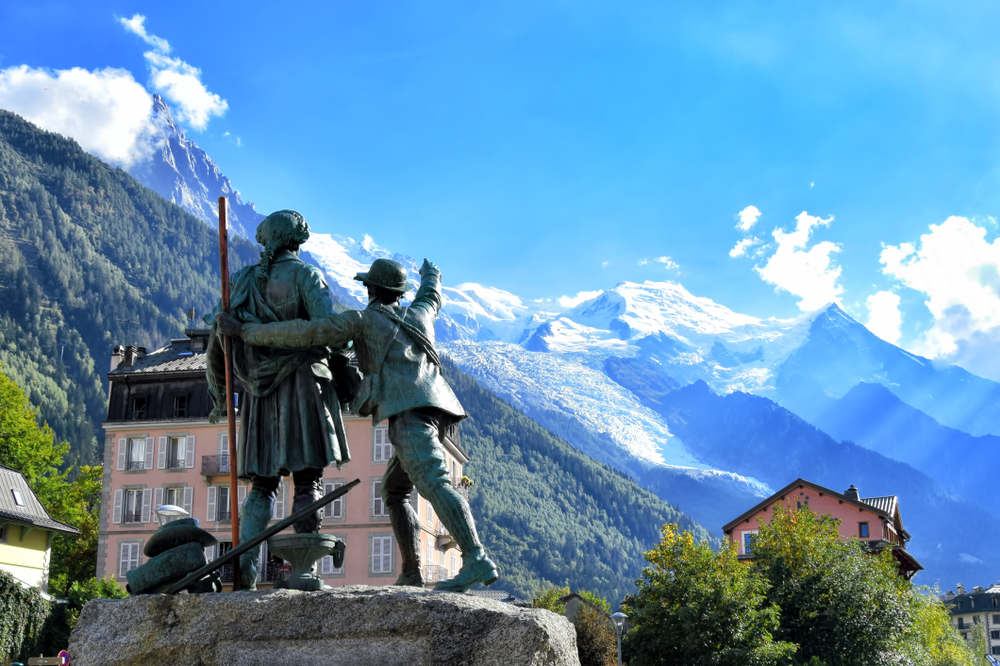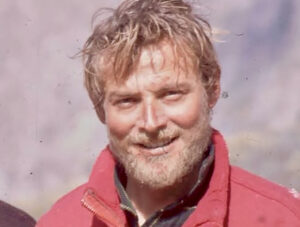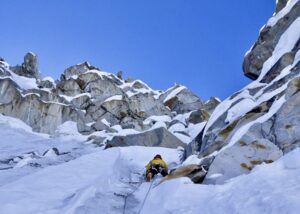The summer season ends soon, but there are still some good days ahead to climb Mont Blanc. If conditions are right, it is a relatively straightforward climb. At the same time, its 4,809m are not to be underestimated. Due to the peak’s popularity, it’s best to plan months in advance.
“People doing guided ascents in 2025 on the normal route should book their climb this autumn,” says Chamonix-based guide Stuart Macdonald. Otherwise, booking beds at Gouter Hut may prove impossible. “The demand for beds is off the scale,” Macdonald says.

Stuart Macdonald, in red, with clients on the summit of Mont Blanc. Photo: Stuart Macdonald
Stuart Macdonald, an IFMGA guide, has climbed in the Alps since the 1990s and moved to Chamonix in 2007. He guides Mont Blanc a maximum of 3-4 times every year. In his career, he has summited the peak over 40 times. “I actually stopped counting years ago,” he admits.
Cradle of alpinism
Mont Blanc, or Monte Bianco in Italian, lies on the border between France (Haute Savoie) and Italy (Aosta Valley). It is the highest peak in both countries, as well as the Alps and Western Europe. Its allure comes from its status as the highest, but there is much more to it. Surrounded by glaciers and jagged peaks in the heart of the Alps, it is near some of the most scenic mountain towns — Chamonix and Saint Gervais in France and Courmayeur in Italy — and is the cradle of mountaineering history. Basically, alpinism was born there.
Moreover, its first ascent by Jacques Balmat and Dr. Michel Gabriel Paccard, and three years later, by Balmat again and Horace Benedict de Saussure, ushered in a new era. It was previously supposed to be a “doomed place” inhabited by malignant supernatural beings, to be avoided.
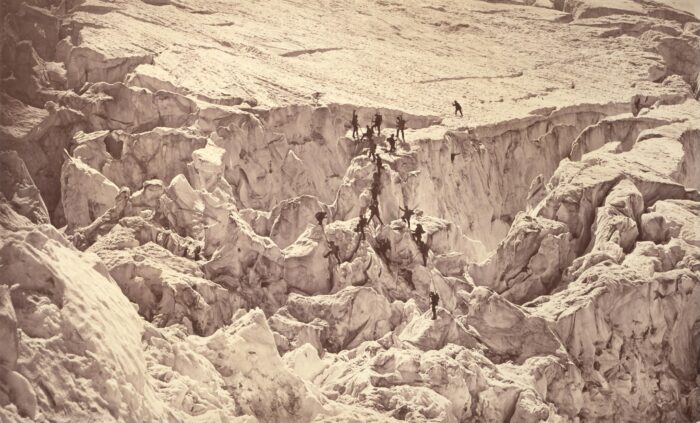
First photo of an ascent of Mont Blanc, in 1860. Photo: August Rosalie Bisson
The first accident on the mountain took place during the 10th ascent, in 1820. Three local guides died in an avalanche, unable to veto their clients, who had insisted on continuing up despite bad conditions. (Sound familiar?) This had a strong impact on public opinion at the time and changed the way future generations approached climbing in the Alps.
The guides united, and on May 9, 1823, they founded the Compagnie des Guides de Chamonix (Company of Chamonix Guides). Similar guiding companies began in Courmayeur and Saint Gervais. Professional guides became essential figures in the evolution of mountaineering in the Alps, which soon became known as alpinism.
Can everyone climb Mont Blanc?
For independent climbers, Mont Blanc is considered a serious challenge. It requires a previous background on lesser peaks and knowledge of how to move safely in glacial and high mountain terrain. Even when assisted by a guide, a strong climbing background is a valuable asset.
Yet many clients often attempt the Roof of the Alps without any background in mountaineering. This is a suitable option if done with an accredited guide who assesses the fitness and experience of potential summiters. So, can Mont Blanc be climbed without previous experience? According to Stuart Macdonald, it can.
“It’s pretty normal for someone arriving for a guided ascent to have no experience, and that’s fine by me,” Macdonald says. “Personally, I have found that the only way to know that people are ready is for them to spend three days training and acclimatizing (sleeping in mountain refuges) before the summit attempt. A novice can arrive, and then be ready a few days later.”
Macdonald insists on leading the acclimatization trips as well. “While some companies are happy for people to do their own acclimatization and training, I’ve found this seldom works and no longer offer it,” he explains.
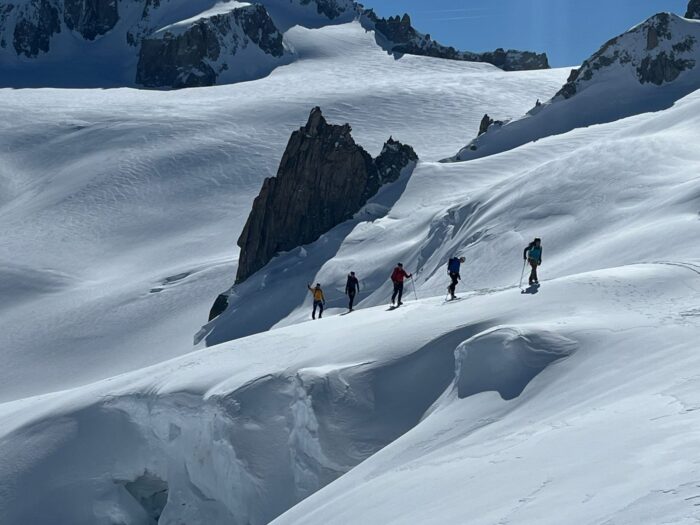
A training day on the Vallee Blanche. Photo: Stuart Macdonald
Preparation is key
“Mont Blanc involves a long summit day, and I find that people who are used to big hiking days, or long-distance runners, usually do best,” Macdonald said.
For novices, Macdonald suggests, “If you can jog your way around a half marathon in two hours or so, then you should be fine. The worst performers are generally gym freaks with a lot of muscle mass but low levels of cardiovascular fitness.”
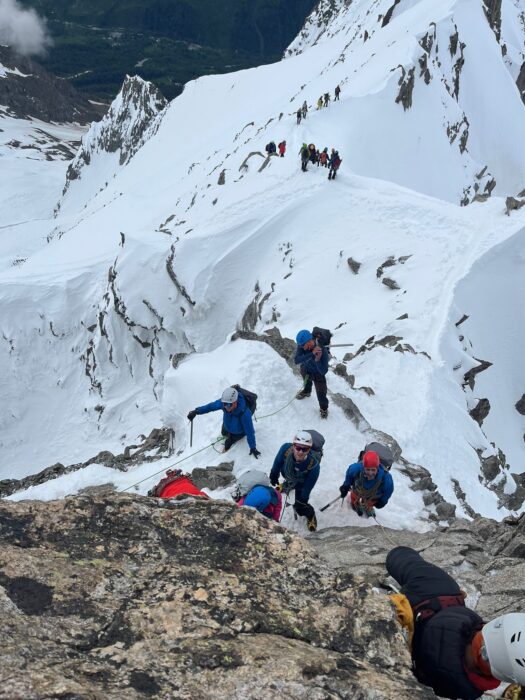
Climbers on a preparatory climb on the Aiguille Marbree. Photo: Stuart Macdonald
Fitness may be a requirement, but it is not enough. “Preparation is everything,” Macdonald says. “I like my groups to sleep at around 3,000m for two nights while training. We will focus on crampon work because slips and trips cause most accidents. We always practice on some steep and challenging terrain, such as the Aiguille Marbree. That way, I can see if anyone will struggle between the Tete Rousse and the Gouter refuges or freak out on the summit ridge.”
After the would-be client puts in adequate preparation time, Macdonald says there’s really only one thing to worry about on Mont Blanc: the weather.
The normal route, step by step
The route along the Dome du Gouter and the Bosses Ridge is by far the most popular route on Mont Blanc for one simple reason. It offers the best chance of success. Interestingly, the route of the first ascent, up the Bossons Glacier, is currently not an option in summer due to glacial retreat. Rather, it is done on skis in winter and spring.
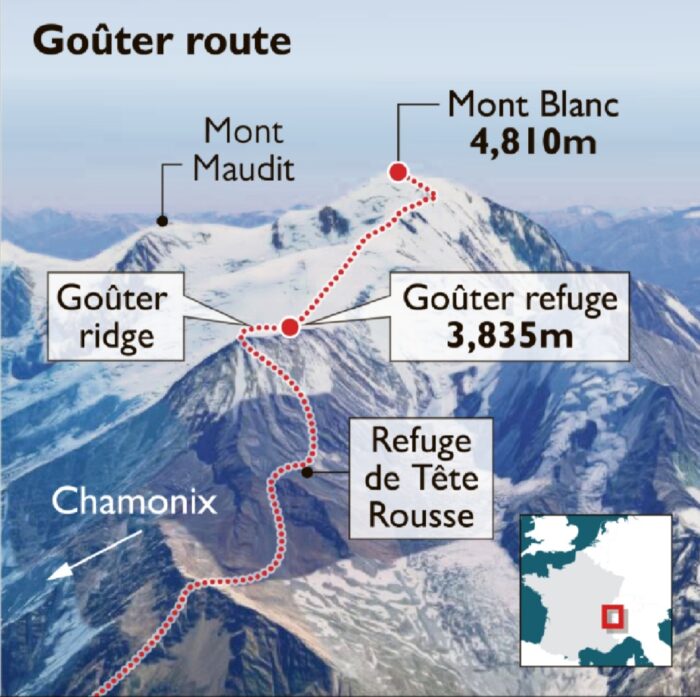
The route to Mont Blanc via the Gouter Route. Photo: Outdooractive.com
Here is how Macdonald does the Gouter Route with his clients, stage by stage and in his own words:
Tete Rousse Hut to Gouter Hut
It starts with a 2.5-hour walk from the train station at Nid’aigle to the Refuge Tete Rousse. From there, you can go to the summit the next day, sleeping in the Gouter Hut on the way down. The most technical section is between the two refuges. Shortly after leaving the Refuge Tete Rousse, you have to cross the Grand Couloir du Gouter.
While technically straightforward, this short section (which takes just a minute or two to cross) is prone to rockfall. Hence, it’s best done when the couloir is snow-filled and frozen. If not frozen, it should be dry (when there is no thawing, and not after a rainfall).
Sometimes, the rockfall gets so bad that the route closes. I’ll only guide the route in June or September, which tend to give the safest conditions. After the traverse of the Couloir, you have to scramble for around two hours up to the Gouter Hut.
The terrain varies from easy paths to low-grade rock climbing. It’s not very difficult, but it is steep, exposed, and you’ll need to be confident. Guided clients are roped up from the moment they leave the hut. There are also cable-protected sections along the way.

Happy faces after safely crossing the Grand Couloir du Gouter. Photo: Stuart Macdonald
Gouter Hut to the Vallot Shelter
When we reach the Gouter Hut, we normally take a break and drop off a few things that we will not need for the summit push. After setting off again, the terrain is quite easy. We go up snowfields until the Vallot Shelter, a small cabin used for emergencies, located at 4,365m. There, we take another break before the final push.
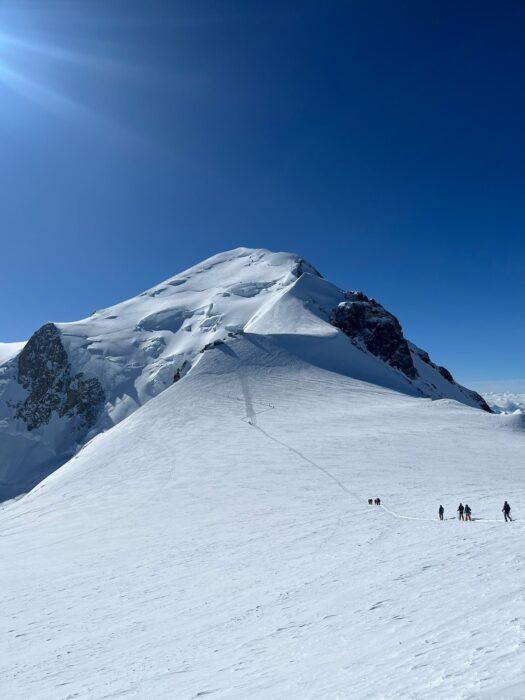
The summit from the Dome du Gouter. Photo: Stuart Macdonald
Vallot Shelter to the summit
Shortly after the Vallot Shelter, we follow the Bosses Ridge to the summit. The ridge is narrow in places and requires good crampon technique and a head for heights. The total time from Tete Rousse to the summit is around seven hours.
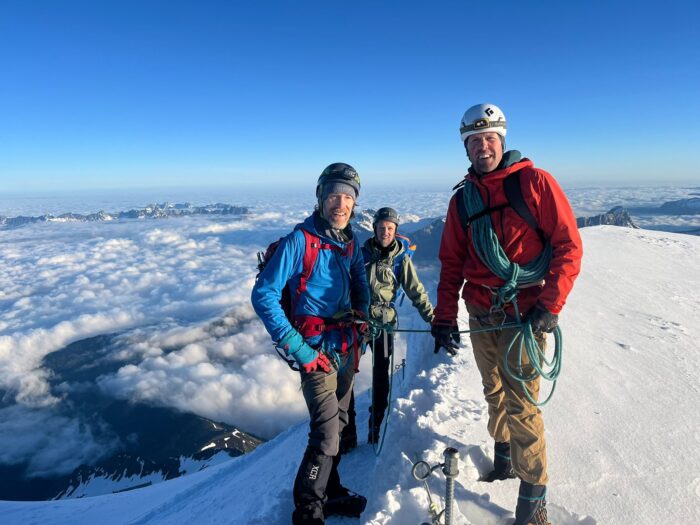
Guide Mike Thomas on Mont Blanc. Photo: Stuart Macdonald
Descent
The descent back to the Gouter Hut takes between two and two-and-a-half hours, and we spend the night there. Using both refuges increases flexibility and safety. Mainly, you don’t have to cross the Grand Couloir in the afternoon (when it’s warmer). If the weather isn’t good enough to summit on the planned day, there is a chance to wait at Gouter and have an early start the next day before heading all the way down.
Alternative: The Trois Monts Route
The alternative Trois Monts (Three Peaks) Route goes from the Aiguille du Midi over the shoulders of Mont Blanc du Tacul and Mont Maudit to the summit of Mont Blanc, Macdonald explained. You can either stay in the Cosmiques Hut the night before, or take the first lift from Chamonix, climb the route, and overnight at Cosmiques after the climb.
“That latter approach means that you will be climbing in daylight when it’s quiet and usually warmer,” Macdonald said. “This route is generally much more quiet than the Gouter Route, but it has some issues to be aware of.”
The slopes of Mont Blanc du Tacul and Mont Maudit are prone to serac fall and perfect for avalanches, he says. “After fresh snowfall, the route needs several days to stabilize. Even though it might be a bluebird day, the route could be completely out of condition.”
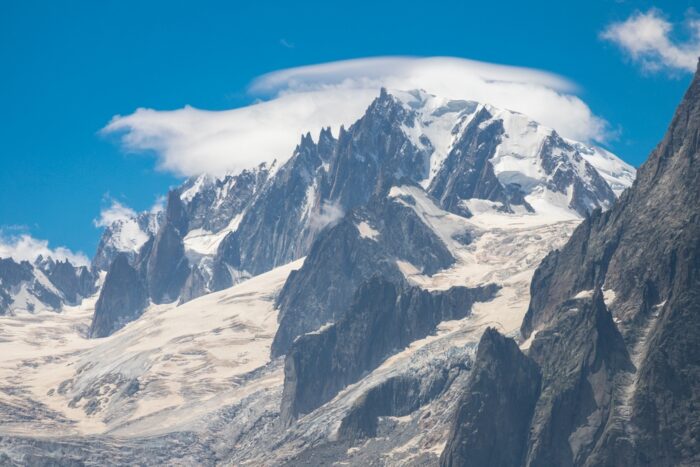
Mont Blanc du Tacul, Photo: Shutterstock
Many fatal accidents have occurred on the slopes of Mont Blanc, including recently. Last week, two climbers died in an unfortunately timed rappel accident. At the beginning of August, another died and four were injured in a serac fall.
The seracs looming over the route may fall any time of day or night and can be difficult to predict. The final issue with this route is that melting glaciers have made it steeper. The route used to be guided at 1:2, but nowadays, the ratio is more commonly 1:1. The Maudit shoulder is definitely more serious than it used to be. To summarize, it’s a great route when the conditions are right.
Pope Route
There is a third option to consider: the so-called Pope Route from Italy. It leaves from Val Veny and proceeds via the Gonella Hut. The name comes after Achille Ratti, who first used that route coming down from the summit. Years later, Ratti became Pope Pius XI.
“It’s a wonderful climb with an incredible feeling of remoteness and solitude, but like the Trois Monts, it has a few problems,” Macdonald noted.
He noted that the approach to the refuge is a solid five-hour slog with no lifts or trains to shorten the way. It requires a perfect weather forecast and top physical shape.
“The refuge is small and nice but suffers from water supply problems,” Macdonald said. “Once the water dries up, it closes for the season, often in late June. At the time of writing this story (late August), Gonella is closed.
“The glacier is steep and complex,” warms Macdonald. “Sometimes it gets too icy, or snow bridges collapse. Either can render the route impassable.”
The ridge above the glacier is also steep. Once on the summit, the options are to return via the same route, which involves an extremely long descent, or to traverse into France. In that case, logistics must be arranged to return to Italy.
Climate change
“Climatic change has affected Mont Blanc enormously,” Macdonald says. “Snow melts out of the Grand Couloir du Gouter faster than before.”
The guide notes that in recent years, the route has been closed most seasons for three to six weeks, something that hasn’t happened before. The Gouter Route has been open all through the season this year but suffered lengthy closures in 2022. Macdonald also mentioned that the glaciers on the Trois Monts route have gotten steeper and more serious.
“Mont Blanc was always a serious mountain, but it’s even more serious now,” he concluded.
